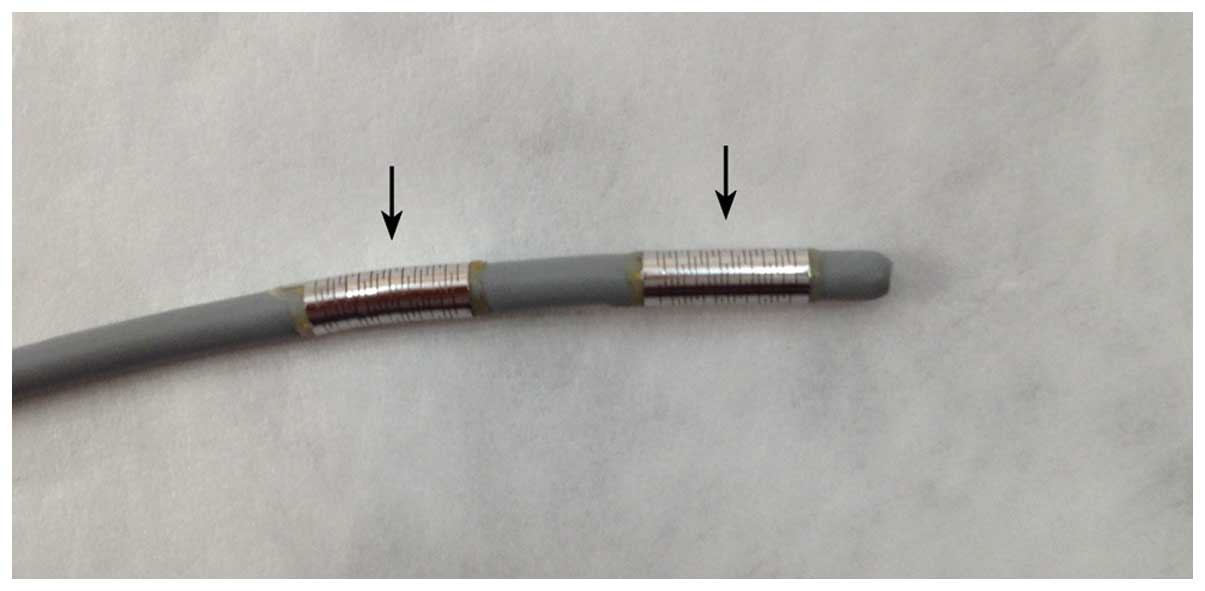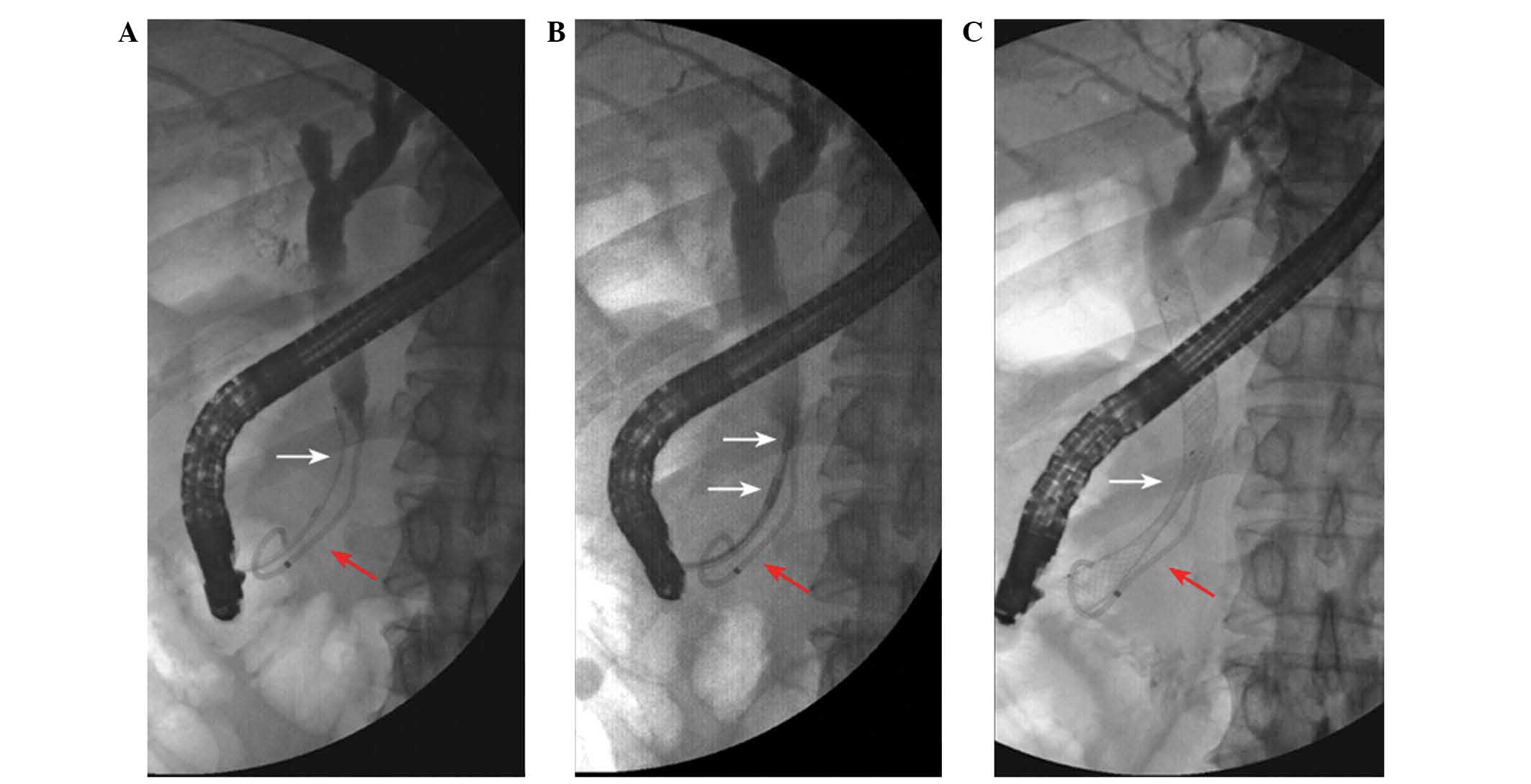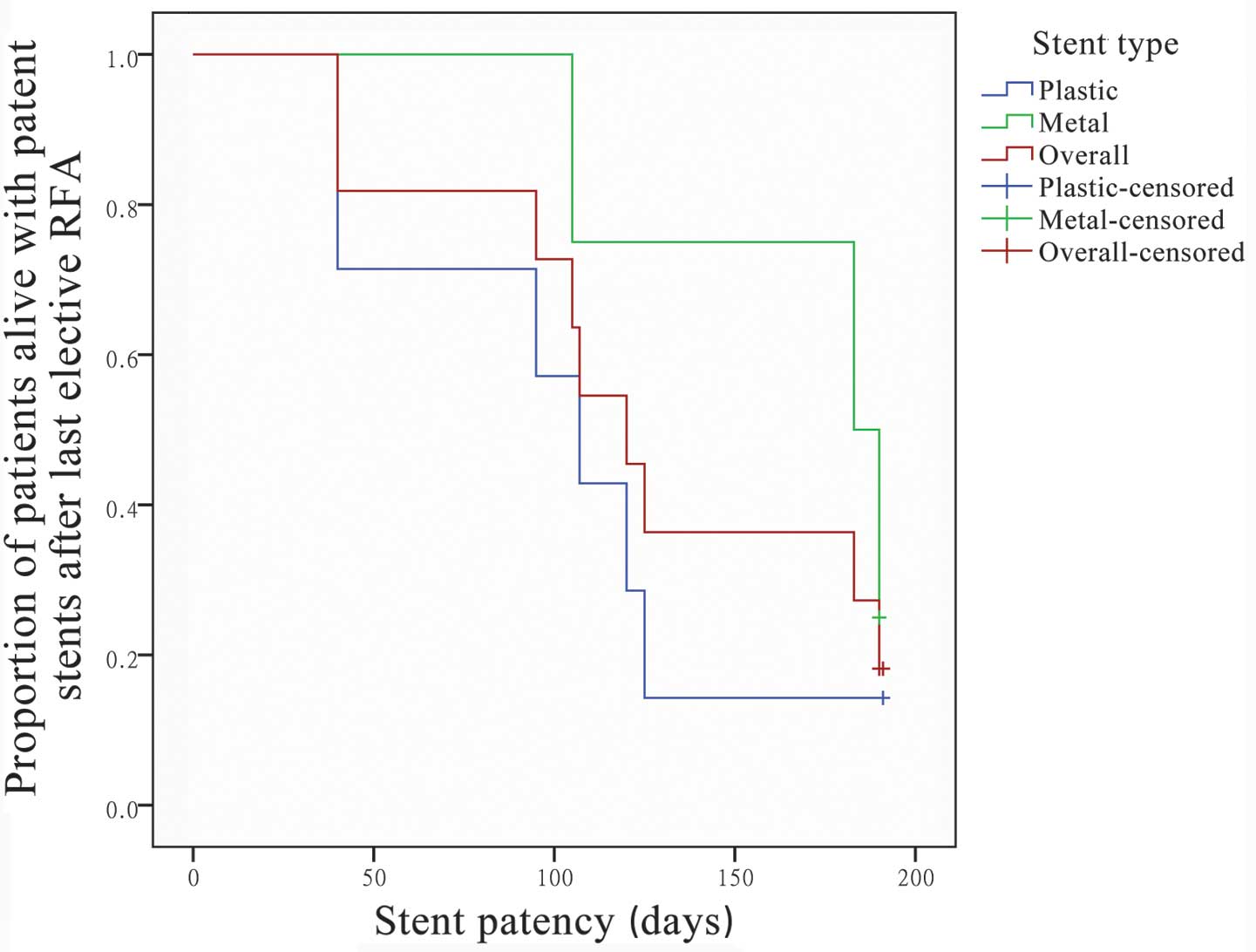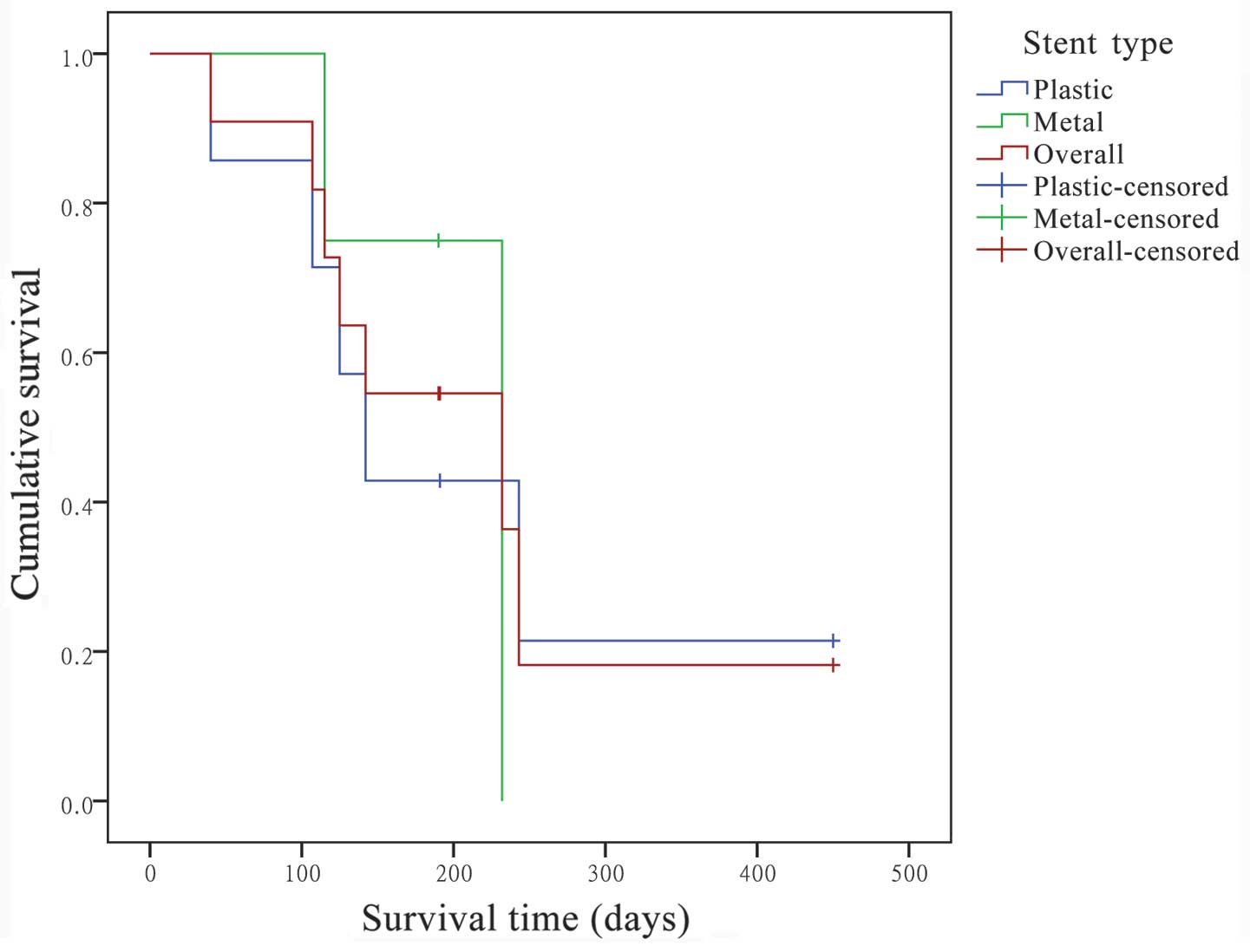|
1
|
Webb K and Saunders M: Endoscopic
management of malignant bile duct strictures. Gastrointest Endosc
Clin N Am. 23:313–331. 2013. View Article : Google Scholar : PubMed/NCBI
|
|
2
|
Moss AC, Morris E, Leyden J and MacMathuna
P: Malignant distal biliary obstruction: A systematic review and
meta-analysis of endoscopic and surgical bypass results. Cancer
Treat Rev. 33:213–221. 2007. View Article : Google Scholar : PubMed/NCBI
|
|
3
|
Shepherd HA, Royle G, Ross AP, Diba A,
Arthur M and Colin-Jones D: Endoscopic biliary endoprosthesis in
the palliation of malignant obstruction of the distal common bile
duct: A randomized trial. Br J Surg. 75:1166–1168. 1988. View Article : Google Scholar : PubMed/NCBI
|
|
4
|
Andersen JR, Sorensen SM, Kruse A,
Rokkjaer M and Matzen P: Randomised trial of endoscopic
endoprosthesis versus operative bypass in malignant obstructive
jaundice. Gut. 30:1132–1135. 1989. View Article : Google Scholar : PubMed/NCBI
|
|
5
|
Kaassis M, Boyer J, Dumas R, Ponchon T,
Coumaros D, Delcenserie R, Canard JM, Fritsch J, Rey JF and Burtin
P: Plastic or metal stents for malignant stricture of the common
bile duct? Results of a randomized prospective study. Gastrointest
Endosc. 57:178–182. 2003. View Article : Google Scholar : PubMed/NCBI
|
|
6
|
Soderlund C and Linder S: Covered metal
versus plastic stents for malignant common bile duct stenosis: A
prospective, randomized, controlled trial. Gastrointest Endosc.
63:986–995. 2006. View Article : Google Scholar : PubMed/NCBI
|
|
7
|
Hong W, Sun X and Zhu Q: Endoscopic
stenting for malignant hilar biliary obstruction: Should it be
metal or plastic and unilateral or bilateral? Eur J Gastroenterol
Hepatol. 25:1105–1112. 2013. View Article : Google Scholar : PubMed/NCBI
|
|
8
|
Donelli G, Guaglianone E, Di Rosa R,
Fiocca F and Basoli A: Plastic biliary stent occlusion: factors
involved and possible preventive approaches. Clin Med Res. 5:53–60.
2007. View Article : Google Scholar : PubMed/NCBI
|
|
9
|
Loew BJ, Howell DA, Sanders MK, Desilets
DJ, Kortan PP, May GR, Shah RJ, Chen YK, Parsons WG, Hawes RH, et
al: Comparative performance of uncoated, self-expanding metal
biliary stents of different designs in 2 diameters: Final results
of an international multicenter, randomized, controlled trial.
Gastrointest Endosc. 70:445–453. 2009. View Article : Google Scholar : PubMed/NCBI
|
|
10
|
Telford JJ, Carr-Locke DL, Baron TH,
Poneros JM, Bounds BC, Kelsey PB, Schapiro RH, Huang CS,
Lichtenstein DR, Jacobson BC, et al: A randomized trial comparing
uncovered and partially covered self-expandable metal stents in the
palliation of distal malignant biliary obstruction. Gastrointest
Endosc. 72:907–914. 2010. View Article : Google Scholar : PubMed/NCBI
|
|
11
|
Kullman E, Frozanpor F, Söderlund C,
Linder S, Sandström P, Lindhoff-Larsson A, Toth E, Lindell G, Jonas
E, Freedman J, et al: Covered versus uncovered self-expandable
nitinol stents in the palliative treatment of malignant distal
biliary obstruction: results from a randomized, multicenter study.
Gastrointest Endosc. 72:915–923. 2010. View Article : Google Scholar : PubMed/NCBI
|
|
12
|
Rumalla A, Baron TH, Wang KK, Gores GJ,
Stadheim LM and de Groen PC: Endoscopic application of photodynamic
therapy for cholangiocarcinoma. Gastrointest Endosc. 53:500–504.
2001. View Article : Google Scholar : PubMed/NCBI
|
|
13
|
Gao F, Bai Y, Ma SR, Liu F and Li ZS:
Systematic review: Photodynamic therapy for unresectable
cholangiocarcinoma. J Hepatobiliary Pancreat Sci. 17:125–131. 2010.
View Article : Google Scholar : PubMed/NCBI
|
|
14
|
Bruix J and Sherman M: Management of
hepatocellular carcinoma: an update. Hepatology. 53:1020–1022.
2011. View Article : Google Scholar : PubMed/NCBI
|
|
15
|
Siperstein AE, Berber E, Ballem N and
Parikh RT: Survival after radiofrequency ablation of colorectal
liver metastases: 10-Year experience. Ann Surg. 246:559–565. 2007.
View Article : Google Scholar : PubMed/NCBI
|
|
16
|
Itoi T, Isayama H, Sofuni A, Itokawa F,
Tamura M, Watanabe Y, Moriyasu F, Kahaleh M, Habib N, Nagao T, et
al: Evaluation of effects of a novel endoscopically applied
radiofrequency ablation biliary catheter using an ex-vivo pig
liver. J Hepatobiliary Pancreat Sci. 19:543–547. 2012. View Article : Google Scholar : PubMed/NCBI
|
|
17
|
Zacharoulis D, Lazoura O, Sioka E,
Potamianos S, Tzovaras G, Nicholls J, Koukoulis G and Habib N:
Habib EndoHPB: A novel endobiliary radiofrequency ablation device.
An experimental study. J Invest Surg. 26:6–10. 2013. View Article : Google Scholar : PubMed/NCBI
|
|
18
|
Steel AW, Postgate AJ, Khorsandi S,
Nicholls J, Jiao L, Vlavianos P, Habib N and Westaby D:
Endoscopically applied radiofrequency ablation appears to be safe
in the treatment of malignant biliary obstruction. Gastrointest
Endosc. 73:149–153. 2011. View Article : Google Scholar : PubMed/NCBI
|
|
19
|
Dolak W, Schreiber F, Schwaighofer H,
Gschwantler M, Plieschnegger W, Ziachehabi A, Mayer A, Kramer L,
Kopecky A, Schrutka-Kölbl C, et al: Endoscopic radiofrequency
ablation for malignant biliary obstruction: A nationwide
retrospective study of 84 consecutive applications. Surg Endosc.
28:854–860. 2014. View Article : Google Scholar : PubMed/NCBI
|
|
20
|
Bismuth H, Nakache R and Diamond T:
Management strategies in resection for hilar cholangiocarcinoma.
Ann Surg. 215:31–38. 1992. View Article : Google Scholar : PubMed/NCBI
|
|
21
|
Cho YK, Kim JK, Kim MY, Rhim H and Han JK:
Systemic review of randomized trials for hepatocellular carcinoma
treated with percutaneous ablation therapies. Hepatology.
49:453–459. 2009. View Article : Google Scholar : PubMed/NCBI
|
|
22
|
Izumi N: Recent advances of radiofrequency
ablation for early hepatocellular carcinoma. J Gastroenterol
Hepatol. 26(Suppl 1): S115–S122. 2011. View Article : Google Scholar
|
|
23
|
Wadsworth CA, Westaby D and Khan SA:
Endoscopic radiofrequency ablation for cholangiocarcinoma. Curr
Opin Gastroenterol. 29:305–311. 2013. View Article : Google Scholar : PubMed/NCBI
|
|
24
|
Tal AO, Vermehren J, Friedrich-Rust M,
Bojunga J, Sarrazin C, Zeuzem S, Trojan J and Albert JG:
Intraductal endoscopic radiofrequency ablation for the treatment of
hilar non-resectable malignant bile duct obstruction. World J
Gastrointest Endosc. 6:13–19. 2014. View Article : Google Scholar : PubMed/NCBI
|
|
25
|
Wang F, Li Q, Ge X, Yu H, Nie J and Miao
L: Choledochoscopic radiofrequency ablation for congenital
choledochal cysts. Endoscopy. 46(Suppl 1): E373–E374.
2014.PubMed/NCBI
|













